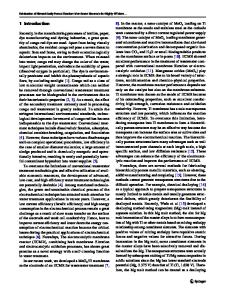Fabrication and characterization of highly porous Ti6Al4V/xTa composites for orthopedic applications
- PDF / 2,158,160 Bytes
- 13 Pages / 595.276 x 790.866 pts Page_size
- 75 Downloads / 340 Views
Fabrication and characterization of highly porous Ti6Al4V/xTa composites for orthopedic applications P. Garnica1, R. Macı´as1, J. Cha´vez2, D. Bouvard3, O. Jime´nez4, L. Olmos2,*, and D. Arteaga5 1
División de Estudios de Posgrado e Investigación, Tecnológico Nacional de México/ITMorelia, Av. Tecnológico # 1500, C.P. 58120 Colonia Lomas de Santiaguito, Morelia, Mexico 2 Universidad Michoacana de San Nicolás de Hidalgo, INICIT, 58060 Morelia, Michoacán, Mexico 3 CNRS, Grenoble INP, SIMAP, Univ. Grenoble Alpes, 38000 Grenoble, France 4 Departamento de Ingeniería de Proyectos, Universidad de Guadalajara, 45100 Zapopan, Jalisco, Mexico 5 Centro de Geociencias, Universidad Nacional Autónoma de México, Blvd. Juriquilla No. 3001, 76230 Querétaro, Mexico
Received: 29 April 2020
ABSTRACT
Accepted: 22 July 2020
This paper presents the processing and properties of Ti6Al4V/xTa porous materials for potential use as bone implants. The processing route includes powder mixing, die pressing and solid state sintering. The porosity was created by 30 or 40 vol.% of salt particles with controlled volume fraction and size distribution, acting as space holders. The microstructure of the sintered materials was characterized by SEM and microtomography. Mechanical properties were deduced from simple compression tests, and permeability was evaluated by numerical simulations performed with real 3D microstructures. The obtained results showed various advantages of the fabricated materials. Their weight densities of the materials processed with 40 vol.% of salt particles were in the range of those of human bones. As a consequence of Ta diffusion, the final microstructures included Ta-stabilized b-Ti phase, conventional a-Ti phase, martensitic a0 -Ti phase, and small residual Ta particles. Also, it was found that both Ta and salt additions reduced the Young’s modulus and the yield stress, while the permeability strongly increased with increasing vol.% of salt particles. Notably, the properties of the material processed with 30 vol.% of Ta particles and 40 vol.% of salt particles were close to those required for trabecular bone implants.
Ó
Springer Science+Business
Media, LLC, part of Springer Nature 2020
Handling Editor: Nathan Mara.
Address correspondence to E-mail: [email protected]
https://doi.org/10.1007/s10853-020-05166-5
J Mater Sci
GRAPHIC ABSTRACT Ti6Al4V / 30Ta with 40 vol.% of pore formers β-Ti-Ta
Ti6Al4V
Weight density = 2.2 g/cm3 Porosity = 55 % E = 2.2 GPa σy = 49 Mpa Admissible strain = 22x10-3 Permeability = 1.8x10-9 m2 Ta particles Blood flow lines
Introduction The specifications of materials suitable for orthopedic implants are numerous: biocompatibility, bioadhesion, non-toxicity, resistance to corrosion and wear, mechanical properties close to the ones of real bones and, last but not least, ability to simultaneously promote, or at least not impede, bone regeneration and osseointegration [1]. This last condition requires a high permeability. In the past years, titanium-based Ti6Al4V alloy (called Ti64 from now
Data Loading...











